Apple announces new MacOS, iOS and all new Macs
posted Monday, June 5, 2017 at 2:00 PM EST

Starting off with a rather cheerful take on the apocalypse (which Tim Cook laughed off, saying he was “so glad that really can’t happen”), Apple’s annual Worldwide Developers Conference saw the debut of seven major updates across platforms, including MacOS High Sierra along with new Macs, iOS 11 and a new 10.5-inch iPad Pro. Apple seems to be trying to show they are listening to users, as their updates to the Mac line address many things professionals have been complaining was missing from the line for quite some time.
More details will likely be available soon, but this is a quick summary of the most pertinent topics we think you'll want to focus on.
iMac Updates
The new iMacs are much improved, with better monitors, faster processors and SSDs, and higher memory capacity. The display has been improved to 500 nits brighter which is 43% better than the current versions. They also have 10 bit dithering (a billion color reproduction). The entire line of iMacs is moving to Kaby Lake, the 7th generation Intel processor. They support 10-bit HEVC decode (better for HQ video) and can be configured to 32GB of RAM on the 21.5-inch and 64GB RAM on the 27-inch machines.
Apple also announced that Fusion drives on their machines will now be standard. For those that prefer SSD, their SSD options are 50% faster and available in up to 2 TB.
The new machines will include two USB-C/Thunderbolt 3 connectors in addition to (and not singularly replacing) the traditional USB connections.
Every configuration in new iMacs gets a big bump in performance. They now include integrated GPU Iris Plus Graphics from Intel for 64MB of eDRAM. This makes them up to 80% faster than the previous generation. The iMac 21.5-inch is getting Radeon Pro 555 & 560 for up to 4GB VRAM. This new system is up to 3x faster than previous gen for graphics. The 27-inch version gets 570, 575 & 580 Radeon processors with up to 8GB of VRAM.
New iMac Features:
- Best displays
- faster processors
- higher memory capacity
- Faster storage
- Better graphics performance
Pricing is also improving, with a new model designed to be more affordable to get their high resolution monitor. The base model 21.5 inch starts at $1099, with the 4K monitor add available for $1499. The 27-inch model starts at $1799.
MacBook Pro
There aren't newly-designed MacBook Pros, but they are getting updated. New MacBook Pros (available today) also now feature Kaby Lake processores, faster SSDs (50%), and a new model that is more affordable:
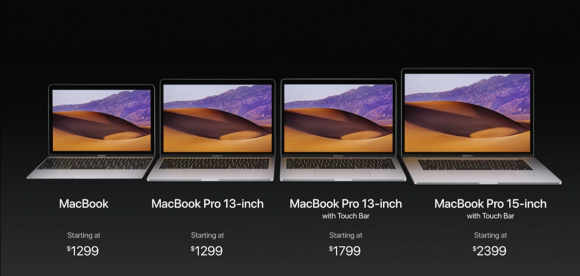
iMac Pro Reveal
Apple showed an upcoming professional computing machine. It's called the iMac Pro and it uses the same design as the iMac but with a “space grey” finish. It’s going to be by far the most powerful iMac... actually it will be the most powerful Mac ever, besting even the Mac Pro which saw a minor spec upgrade in April and has not seen any major upgrade since the line moved to a cylindrical design in December 2013. Apple are going to put workstation-class performance in the iMac design, which required a better cooling system (see below). It’s still very quiet, but way more powerful.
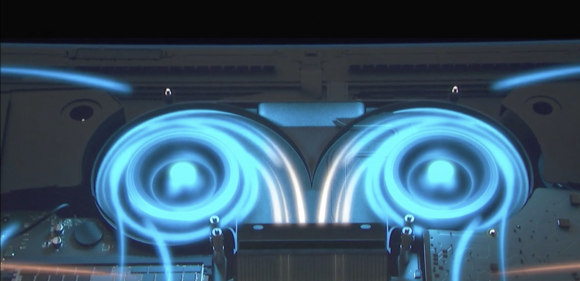
The iMac Pro will ship with an 8-Core Xeon Processor, but it will also come with 10-Core Xeon Processor option. However, you can ALSO can get up to an 18 Core Xeon Processor. It will feature a Radeon Vega Graphics from AMD, which is a totally new GPU core. It will be available with 16GB of VRAM, and this implementation will offer 11 teraflops of single precision computation and 22 teraflops of half precision computation. You can configure with up to 128GB of ECC memory (insane) and up to 4TB of 3GB/S SSD. It will feature four thunderbolt 3 ports, four USB-3.0 ports, and built-in 10 GB ethernet.
With the kind of computing power in the iMac Pro, you can hook up two more 5K displays and 2 high performance raid arrays. This means that the iMac Pro can drive up to 44 million pixels.

Apple says it will be available in December starting at $5000.
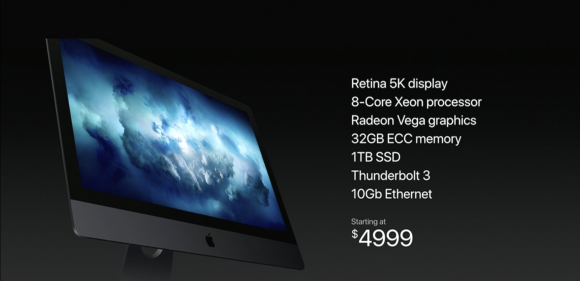
MacOS High Sierra
Apple claims that Safari is “the world’s fastest desktop browser with High Sierra.” It delivers 80% faster performance than Chrome. In addition to speed, they also instituted autoplay blocking, allowing you to avoid annoying videos that play when you load a page and let you decide when/if a video plays. Safari also has Intelligent Tracking Prevention, which uses machine learning to identify tracking of any kind, and protects privacy. It's not just about ads, but any of your browsing habits. On the surface, this looks like it could be as effective at blocking browsing history as a VPN.
Apple also made Photos on the Mac better, by letting you filter by keywords, favorites, media types, etc. They improved facial recognition in images, and when you put effort into categorization and naming, that syncs across devices. They also made enhancements to editing photos: They added curves, selective color (cool I guess), and any edits you make in Photoshop sync with the Photos app. Printing services like Animoto, Wix and Shutterfly are now partnered with Apple Photos for printing services.
The Mac file system, HFS, is over 30 years old. Apple is changing to a new file system, Apple File System or APFS, to Mac. It’s 64 bit top to bottom, with safe and secure build. It’s ultra responsive and fast. With the new system, files duplicate and transfer MUCH faster than before. In video, Apple is supporting H.265 which will save 40% better compression. All apps will support the new format.
High Sierra is on developer beta today, there is a public beta at the end of June, and a free update this fall to everyone.
iOS 11
There are a lot of changes to iOS 11, but here are some of the things we thought would interest you. Messages has a redesigned app drawer, for faster and easier access to stickers and interactive messages. Messages are now stored in iCloud, and all conversations automatically synchronize (finally) across devices. With Messages in the cloud, only the most recent messages are cached on the device with the rest are stored in the cloud, reducing storage on your device.
By EOY, more than 50% of retailers will support Apple Pay. To make it even beter, Apple is introducing person-to-person payments. It will be integrated into Messages, so you can send and receive money via the messages app. Authenticated via touch ID, money sent to you goes into an Apple Pay cash card in your Wallet, you can make purchases with it, pay others with it or you can transfer to a bank.
Siri has a much more human voice, which includes better inflection and a more "human" sound. One word can be said multiple ways, as you probably know, and now Siri has the ability to know when to say something a certain way. She has a new visual interface, and can provide multiple results to queries you pose to her. You can now use her to translate as well. Ask her anything, and she will repeat it in the correct language. At launch, it will support English to Chinese, French, German, Italian and Spanish, with more languages coming soon.
Siri will understand your voice, and context. Interests, usage of your device, etc. can be used to better understand what you’re asking for. She uses on-device learning to better understand topics of interest to each user. Additionally, Siri is synced across devices now.
Control center is being redesigned: it’s now a single page with all the features that used to be spread across two. 3D touch gives you more controls on each of the buttons, which let them compress the view and only show you more when you need it.
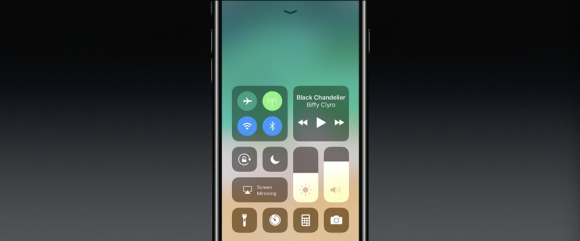
Lock screen and notification center are now one item. Swiping down now shows the lock screen and older notifications can be accessed as well.
Camera Improvements:
With the newest update, Apple is introducing HEVC compression for up to 2x better compression with high resolution video. The video quality won't suffer, but it will take up considerably less space on your phone. They are also replacing JPEG capture with a file type called HEIF, which maintains quality at half the size (2x better compression). All this said, Apple promises that their phone is still compatible across all devices, Apple or not.
With the camera specifically, Apple says they improved image quality and low light performance. Optical image stabilizer is better, too. Developers can now have access to the Depth API.
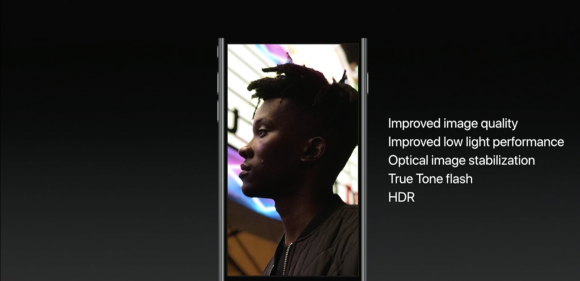
Live photos are improved, and editing of the live photo is now enabled. Sometimes the best photo isn’t the still, but something inside the live photo. Now you can edit it so that the key photo is whatever was captured in the live photo. They also added looping of live photos, edited to your liking. You can also loop in reverse, which is popular on gifs these days. You can also add long exposure looks with your phone without a tripod, it can do it all in the camera. It’s just an editing option now.
Apple says that in Photos, Memories is better thanks to the use of machine learning to identify events like weddings, anniversaries, sporting events, etc. You can view movies it makes in portrait as well as landscape mode.
iPad Pro
Apple also announced a new size to its high-end iPad Pro lineup, a 10.5-inch model, which replaces the smaller 9.7-inch "Pro" tablet. Sitting below the larger 12.9-inch model, the new 10.5" iPad Pro offers an increased screen real size thanks to its thinner, narrower bezels. The larger screen offers a full-sized on-screen keyboard. It, along with the 12.9-inch model, gains a processor speed bump, going to an A10X Fusion chip. The displays on both iPad Pro models get upgraded display technologies, as well, with 50% brighter True Tone displays and "Pro Motion" technologys that offers up to 120Hz refresh rates. Storage capacity for both new iPad Pro models begins at 64GB. Prices start at $649 for the 10.5-inch model, and $799 for the 12.9-inch one.